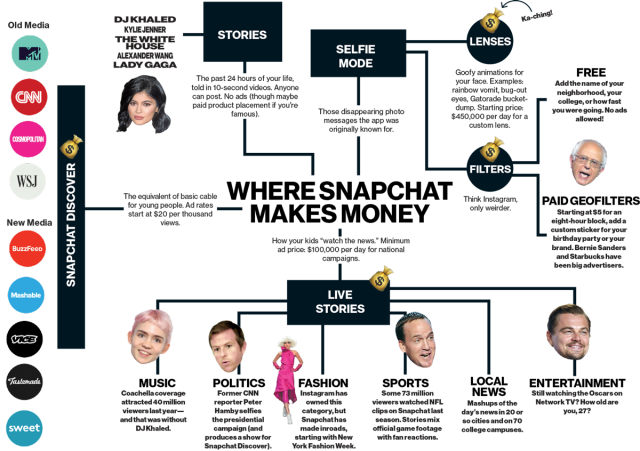Snapchat has become one of the bigger social media success stories of the past year, with millions of users providing content for others to see, and brands taking part to a much larger degree. Now, new numbers indicate that its success is as strong as ever.
The Wall Street Journal recently posted a video explaining how the company has grown to 100 million monthly users, a new landmark record for a social media application. On top of that, it managed to raise another $175 million in its latest round of funding, although its valuation still remains at $16 billion. Although some behind-the-scenes business types are concerned that the valuation hasn’t risen since last year, there’s no questioning the effectiveness of its business model.
Meanwhile, Bloomberg Business recently explained how Snapchat was able to build a $16-billion dollar business based on a younger viewer demographic, “confusing olds” in the process. It mostly focuses on 40-year-old music producer Khaled Khaled, also known as DJ Khaled, who is rising in the ranks as one of the app’s more popular users, having amassed an audience of over six million followers since last October. “Life is like flowers,” he noted. “You grow. You blossom. You become great.”
Granted, a lot of that success can come from involvement with the right people, like how Khaled worked alongside Ciroc Vodka to produce Snapchat ads, but it still demonstrates that even a service based on temporary content can thrive. “DJ Khaled has completely cracked the platform,” noted Emmanuel Seuge, senior vice president for content at Coca-Cola, which does quite a bit of advertising on the app. “He’s the king of Snapchat.”
Of course, Snapchat isn’t for everyone. It’s built specifically for users to share their stories, instead of simply embarrassing themselves or making a channel without much purpose. “It’s much more for sharing personal moments than it is about this public display,” noted co-founder Evan Spiegel earlier this year.
Elissa Ayadi, vice president of social strategy for Ayzenberg, noted, “Snapchat is building a best friends network. They get confusingly lumped into social networks, but that’s not what they’re trying to be. They’re specializing in one-to-one communication.”
While the revenue for the app is reportedly small–around $200 million annually according to various press reports–its cavalcade of advertisers and business venues make up a steady stream of revenue flow. Partners like Pepsi, Amazon and Budweiser paid over $1 million to feature ads coordinated with Super Bowl coverage–far less than the asking price CBS had for televised advertising during the “big game” itself.
But brands aren’t necessarily encouraged to use the Snapchat app the “normal” way, according to Ayadi. “Snapchat actually doesn’t encourage brands to be on the platform. They encourage them to use their paid options like photo filters or the Discovery channels.”
Khaled also manages to attract a younger demographic and his videos bring in between three to four million viewers each time. Considering how a similar demographic, 3.3 million in the 12-34 age range, watches The Big Bang Theory on CBS, that’s pretty significant.
“Snapchat lends itself well to people like DJ Khaled because it enables that one-to-one communication. He’s creating content that feels personal. It feels like content you can’t get anywhere else and like something you’d send to your best friend. It’s not overly marketed—it’s not overly produced—if he tells you to go get his new single, he’ll do it with his characteristic key emoji,” noted Ayadi.
That same age group also watches Live Stories regularly, with around 41 percent of adults under the age of 35 spending time viewing this content on Snapchat. “Everybody from 14 to 24 in America, it’s either the No. 1 or No. 2 app in their lives” following Instagram, states Gary Vaynerchuk, angel investor and entrepreneur.
As for where Snapchat finds its value, it mostly lies between Stories, Selfie Mode, its various Filters (which usually find sponsorships) and Live Stories. Out of all of these, Live Stories appears to be the biggest, attracting everything from sports to music.

“If brands decide to have an organic presence on Snapchat, they have to create content that is compelling. They have to create content that is within the lens of Snapchat and get a little outside of their brand’s comfort zone. Things like offers or sales and traditional marketing messages are not appropriate for Snapchat,” said Ayadi.
She also noted that the right approach should be used when it comes to creating content. “Snapchat’s content creation can be very involved. It’s meant to be up-to-the-second and because Snapchat’s content is typically captured in the app, it has a certain quality bar that users expect which is actually very low. Trying to do anything super high-concept, super-branded, or in the case of a brand working with an agency, content that requires approvals ahead of time, is almost impossible.”
It’s clear that Snapchat’s success is hardly “flash in the pan,” and superstars like Khaled continue to keep it going strong.

